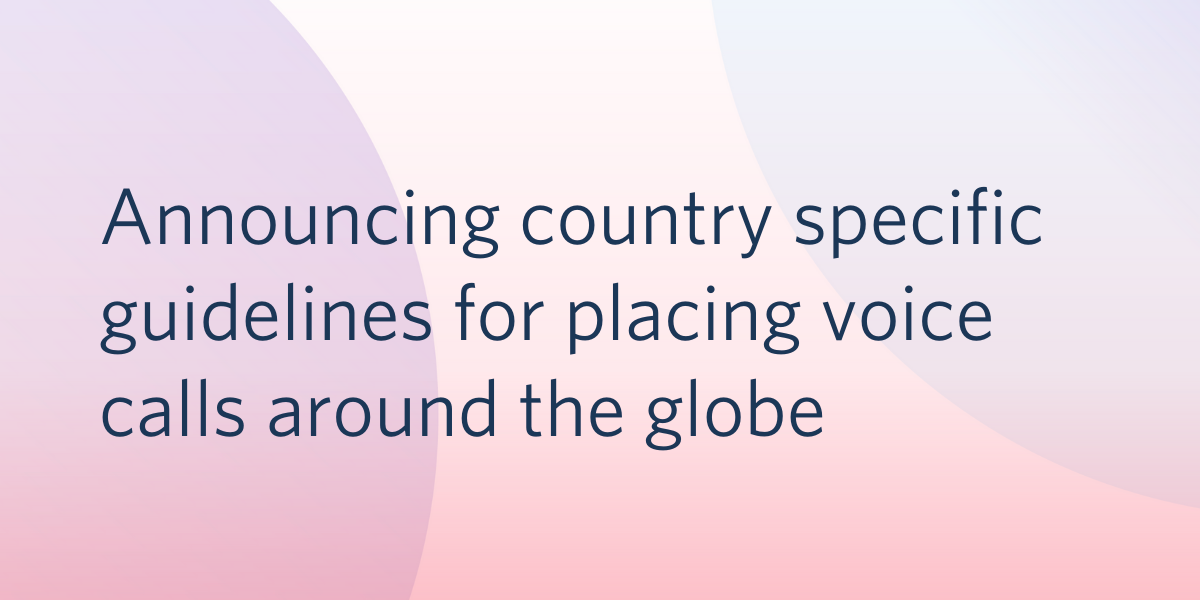Announcing Country specific Guidelines for placing Voice calls around the globe
Time to read:

Today, we’re excited to introduce global Voice Country Guidelines. It’s an online resource that spells out the different rules and best practices for placing Voice calls around the world. It’s available today on our website.
While placing a Voice call to someone in another country seems pretty straightforward, navigating the intricacies of Voice calling in any given country around the globe is actually quite tricky.
For starters, different countries and carriers have different definitions of what acceptable traffic profiles are. For example, the percentage of short duration calls is one key indicator of SPAM or Fraudulent calling for many carriers. Carriers in the United States might consider a short duration call to be one that lasts less than 12 seconds, whilst in China many Carriers consider them short if they last less than 3 minutes!
It's also very important to understand Voice calling feature support in each Country where you'll be placing calls to and from, especially as it pertains to Caller Identification and touch tone support.
If you don't understand the details of how Voice calling is supported in a given country, we jointly run the risk of your call not completing, or completing without the expected feature functionality. This is where global Voice Country Guidelines comes in. It gives you an online resource with information like reachability by call type, feature support and carrier requirements to help you ensure you have compliant traffic profiles and you're fully aware of Twilio's Super Network capabilities in each Country.
There are a few important categories of information you need to be aware of if you're going to be calling around the globe:
1) Reachability
It's important to understand if Twilo is able to complete calls to Phone Numbers in a given country. More specifically can in-country numbers be reached locally within the country? Can in-country numbers be reached from outside the country? Can in-country Toll-Free numbers be reached from within the country?
2) Understand Features supported (CallerID & DTMF)
Caller Identification and Dual Tone support are the two features that tend to be problematic in different countries around the world, therefore having a good understanding of what's supported in each country is important:
- CallerId Domestic (within a given country) and International (from outside the country into the given country) support? Typically the format supported will be E.164.
- Are DTMF tones supported using RFC2833?
3) Follow local carrier guidelines
Different countries have different sets of guidelines/requirements around the traffic profiles. It might be the minimum average call duration, the use of repetitive CallerIds, etcetera. Twilio gives you this kind of information, so you have better awareness of local guidelines and can adjust your traffic to ensure the best possible call completion.
These country specific Voice guidelines are available today and we’ll continue to update and add more information over time. If you send or receive Voice calls from multiple countries, chances are you’ll want to keep this resource bookmarked.
Get started here.
We can’t wait to see what you build!
Related Posts
Related Resources
Twilio Docs
From APIs to SDKs to sample apps
API reference documentation, SDKs, helper libraries, quickstarts, and tutorials for your language and platform.
Resource Center
The latest ebooks, industry reports, and webinars
Learn from customer engagement experts to improve your own communication.
Ahoy
Twilio's developer community hub
Best practices, code samples, and inspiration to build communications and digital engagement experiences.

